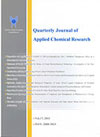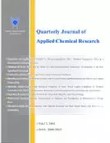فهرست مطالب

Journal of Applied Chemical Research
Volume:13 Issue: 2, Spring 2019
- تاریخ انتشار: 1398/03/09
- تعداد عناوین: 8
-
-
Pages 8-171, 4-Diazabicyclo [2.2.2] octane (DABCO) was employed as a catalyst for one-pot synthesis of pyrano[2,3-d] pyrimidinone derivatives and MWNT- pyrimidinones from condensation reactions of aromatic aldehydes, malononitrile and thiobarbituric acid and MWNT-COCl . This method delivers the advantages of a simple method, environment friendly procedure, mild reaction conditions and high returns. The materials were characterized by Fourier transform infrared spectroscopy, nuclear magnetic resonance, mass spectroscopy, elemental analysis, scanning electron microscopy and Thermogravimetric analysis.Keywords: MWNT, Pyrano[2, 3-d]pyrimidinone, Thiobarbuturbic acid, Malononitrile, Aldehyde
-
Pages 18-35Cobalt has great biological effects on human beings and also other living organisms, hence its determination is very important. In this regard, a novel coated graphite electrode was designed for determination of Co2+ ions by exploiting 6-chloro-11- azabenzo[a]phenothiazin-5-one as a neutral ion carrier, for the first time. The foremost function was witnessed from the membrane composition of PVC (29%), Potassium tetrakis (4-chlorophenyl) borate (2%) as an ionic additive,6-chloro-11-azabenzo[a]phenothiazin-5-one (9%) as ionophore and Dioctylphthalate (60%) as Plasticizer. The linearity domain of the membrane sensor was from 5×10-7 to 1×10-2 Mol L-1 with the Nernstian slope value of 30.1 mV.Decade-1. The potential response of the designed electrode was also investigated in non-aqueous mediums and it was found out that the electrode is also able to be used in systems that are entailed of 20% of ethanol and acetone organic solvents. The response time and lifespan of the electrode was 5 S and 3 months respectively. The sensor selectivity was also evaluated by match potential method over other cations and it shows an eminent selectivity towards Co2+ over all of the inspected ions. The applicability of the electrode in the potentiometric titration with EDTA was also investigated. In the end, the proposed electrode was utilized for determination of Co2+ in four aqueous specimens as real samples.Keywords: Cobalt (II), 6-chloro-11- azabenzo[a]phenothiazin-5-one, Ion selective electrode, Potentiometry
-
Pages 36-50A rapid, simple and sensitive magnetic solid phase extraction (MSPE) method was developed for the pre-concentration and determination of copper and cadmium ions. In this study, modified Fe3O4@Ag nanoparticles were synthesized and then ligand 2-isonicotinoyl hydrazine carbodithiolate (ITHCDT) was bonded to silver due to the formation of covalent bond of S-Ag. In this method, copper and cadmium ions were absorbed on the sorbent and then eluted by 1 mL of HCl (2 mol L-1) and measured by FAAS. Different effective parameters such as pH, eluent type and volume, amount of sorbent, sorption capacity, contact time were investigated and optimized.Relative standard deviation (RSD, n=7) under optimum condition for Cd (II) and Cu(II) was 1.23% and 1.67%, respectively. Limit of detection (LOD) of the method for cadmium and copper was 0.87 and 0.51 μg L-1, respectively. The proposed method was successfully applied for the determination of trace amounts of copper and cadmium ions in water samples.Keywords: Modified magnetic nanoparticles, cadmium, copper, Flame atomic absorption spectrometry, Water samples
-
Pages 51-65Polyvinyltetrazole (PVT) is produced from acrylonitrile (AN) monomer by using free-radicalpolymerization and Click Chemistry methods. The resulting polymer with a broad range of tetrazolegroup contents was conveniently synthesized through [3+ 2] azide-nitrile cycloaddition reaction ofnitrile-containing polymer with sodium azide in DMF. The prepared PVT was characterized by13CNMR,FT-IR and UV-Vis spectroscopies. Elemental analysis indicated that approximately 92% ofthe cyano groups on the polymer surface were converted to tetrazolyl groups. The PVT exhibitedexcellent adsorption form et al ions and the maximum adsorption capacity for Pb (II) was2.39mmol/g which are much higher than corresponding literature results. The adsorption processwas described as an ion exchange and chelation interaction mechanisms. The high adsorption rate(<40 min) was seen. The resulting polymer and its metal chelate were characterized by FT-IR,elemental analysis, gravimetry, scanning electronic microscopy (SEM), thermogravimetry analysis(TGA), UV-Vis spectroscopy, and atomic absorption techniques (AAS). All these analyses methodsconfirmed the presence of metal in the polymer-metal complex.Keywords: Free Radical polymerization, Click Chemistry, Acrylonitrile, Heavy Metal Ions, Adsorption
-
Pages 66-80An environmentally friendly, facile and solvent-free synthetic route for aluminum sulfate octadecahydrate (Al2(SO4)3.18H2O) catalyzed one-pot multi-component synthesis of 12-aryltetrahydrobenzo[α]xanthene-11-ones, 1,8-dioxo-octahydroxanthenes and 14-aryl-14Hdibenzo[α,j]xanthenes has been developed. The readily, easy to handle, non-toxic, environmental friendly and low-cost catalyst, easily separated with no column chromatographic separation, short reaction times and high to excellent yields is an option for the economical, mild and facile synthesis of these rings.Keywords: Aluminum sulfate octadecahydrate (Al2(SO4)3.18H2O), Facile, eco-friendly, solvent-free synthesis, 12-aryl-tetrahydrobenzo[α]xanthene-11-ones, 8-dioxo-octahydroxanthenes, 14-aryl-14H- dibenzo[α, j]xanthenes
-
Pages 81-88A highly efficient and convenient procedure for the enantioselective synthesis of (S)-Rivastigmine tartrate, a cholinergic agent for the treatment of mild to moderate dementia of the Alzheimer’s disease, is accomplished by the treatment of versatile, readily accessible N-Ethyl-N-methyl carbamoyl chloride with 3-hydroxyacetophenone under ultrasonic irradiation in presence of nano-K2CO3 were reported. This protocol provided a high yielding stereoselective and short synthesis of (S)-Rivastigmine tartrate with an overall isolated yield of 83%. All the starting reagents and catalyst are inexpensive and commercially available.Compared to conventional heating which provides thermal energy in the macro system, ultra sonification reduces reaction times, improves yields and minimizes side product formation by providing the activation energy in micro environment. As this technology involves energy conservation and minimal waste generation, it is widely accepted as a green chemistry approach. The reported strategy afforded under ultrasonic irradiation and in presence of Nano-K2CO3 via four steps, which (to the best of our knowledge) depicts the shortest and the most rapid method to enantiopure Rivastigmine tartrate reported to date.Keywords: Synthesis, Rivastigmine, Nano-K2CO3, Alzheimer’s disease, Ultrasonic irradiation
-
Pages 89-96A practical and green approach for the one-pot multicomponent synthesis of fused tetrazolo[1,5-a]quinazoline derivatives has been described via the condensation of 5- aminotetrazole, dimedone, and various aldehydes using 1-butyl-3-methylimidazolium tetrachloroaluminate [bmim]Cl/AlCl3, as a catalyst and task-specific ionic liquid medium. The catalyst was showed remarkable advantages in comparison with previous methods. Short synthetic route, operational simplicity, high-to-excellent yields, eco-friendliness and mild reaction conditions are the advantages of this method.Keywords: Ionic liquid, [Bmim]Cl, AlCl3, Tetrahydrotetrazolo[1, 5-a]quinazoline, 5-aminotetrazole
-
Pages 97-106One-pot four-component synthesis of polyfunctionalized 1,4-dihydropyridine derivatives was developed by a condensation of aldehydes, malononitrile, diethylacetylenedicarboxylate and aniline in the presence of choline chloride/urea as a deep eutectic solvent (DES)at room temperature.Moreover, an efficient method was reported for the synthesis of highly substituted 4H-chromenes through one-pot, three-component reactions of cyclohexane-1,3-dione or dimedone, malononitrile and diethylacetylenedicarboxylate, in the presence of the deep eutectic solvent at 60 °C. This method develops by using an environmentally benign synthetic method along with the use of a costeffective catalyst.Keywords: Multicomponent reactions, Deep eutectic solvent, 4-Dihydropyridine, 4H-chromene, Diethylacetylenedicarboxylate


